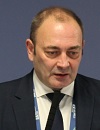 |
||
|
Core module of Linglong One is in place CNNC, PUBLISHED 13.08.2023 On August 10th, the core module of the Linglong One reactor, a multi-purpose modular small reactor in Hainan, a subsidiary of China National Nuclear Corporation (CNNC), was lifted and moved towards the nuclear island. Pressure vessel, evaporator and other key equipment were installed in one step, marking the peak phase of Linglong One's installation. This is the first milestone of the installation of Linglong One nuclear island. It marks the debut of modular manufacturing and installation of nuclear reactor modules, representing a historic step of global nuclear miniaturization and highlighting China's leading position in the modular manufacturing of small pressurized reactor units. The core module, also known as "the heart of Linglong One", is Linglong One's core components. It integrates pressure vessel, evaporator, and primary pump receiver, and removes the main pipeline. The steam generator is inside the reactor pressure vessel. Before the lifting, the steam generator already undergone joint welding with the reactor pressure vessel at the factory, effectively integrating the "lungs" and "heart" of the nuclear power plant. It is the most challenging and representative nuclear power main equipment featuring "factory prefabrication and modular manufacturing" processes. The design and construction of Linglong One are revolutionary and groundbreaking. Modular construction is its most prominent feature. Through standardized design, single module production, and mass production, it shortens the construction period and reduces costs while improving safety. The modular small reactor has a simplified system and small size, which is convenient for transportation and operation. It allows flexible adjustments and construction according to users' requirements, resulting in significant economic benefits. The Hainan Nuclear Power Multi-purpose Modular Small Reactor Technology Demonstration Project is the world's first commercial land-based small modular pressurized water reactor. Upon its operation, it is expected to generate one billion kilowatt-hours of electricity per year, which could meet the needs of 526,000 households and is equivalent to reducing around 880,000 tons of CO2 emissions or planting 7.5 million trees. With its stable and reliable clean energy supply, it will contribute to China's carbon peaking and carbon neutrality goals and the construction of a "clean energy island" in Hainan, and drive the development of nuclear energy worldwide. Topics: Small NPP, Asia, China Other news: The core module of the Linglong One reactor passes final acceptance The core module mainly consists of two key components: the pressure vessel and the steam generator. ROSATOM starts testing MOX fuel for VVER reactors For irradiation in the MIR reactor, 21 MOX fuel rods had been manufactured. ROSATOM plans to construct SHELF-M reactor plant in Chukotka The land-based small nuclear power plant with the SHELF-M reactor is planned to be commercially operational by 2030. |
Hero of the day 
Unit 2 of the Belarusian NPP included the unified energy system of the Republic of Belarus The grid connection at the reactor power of 40% of the nominal one confirms the availability of all its systems and equipment for electricity generation. In the coming days, specialists will increase the reactor power up to 50% and carry out a series of dynamic tests. INTERVIEW
AtomInfo.Ru OPINION
Note Verbale from China to IAEA |

